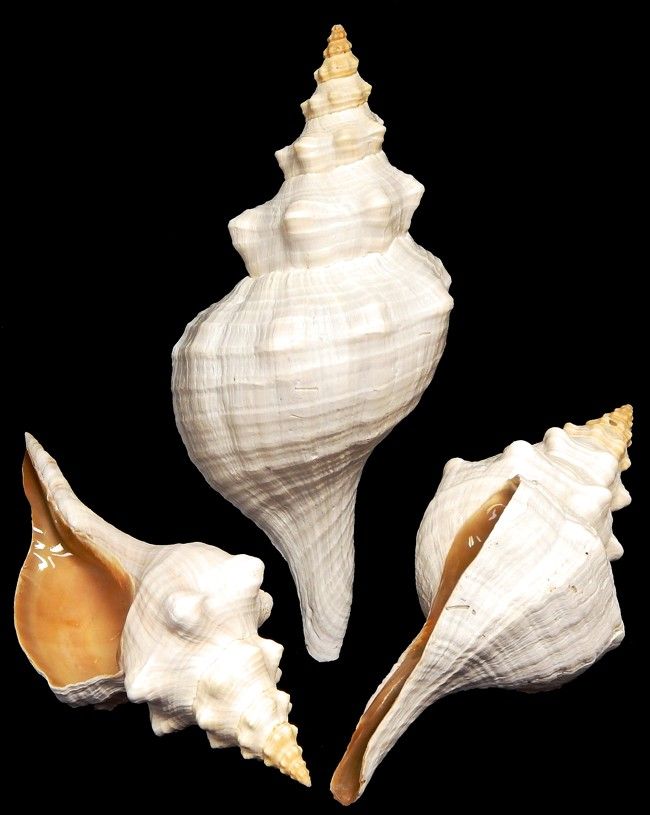Triplofusus giganteus (the Horse Conch) shell measuring 8 to 10 inches *****
One Triplofusus giganteus (the Horse Conch) Shell measuring 8 to 10 inches
Orders usually process within 2 to 5 business days.
Email us at ja1@mindspring.com Make Your Selections and Shipping Preference. We Will Email You the amount of the Shipping Cost. When you receive the shipping cost go back into Shells of Aquarius and click into Purchase Shipping Label. There you will find UPS or USPS. Click into the option you decided on and make your payment. Your order will ship when shipping payment is received.
The Horse Conch species belongs to the of the large predatory subtropical and tropical sea snail, a marine gastropod mollusk in the family Fasciolariidae, the spindle snails, tulip snails and their allies.
The horse conch is not a true conch, it is not in the family Strombidae.
Triplofusus giganteus shell are known to grow up to 23 inches, this species is the largest gastropod in United States waters, and one of the largest gastropods in the world.
The largest known specimen of Triplofusus giganteus had a shell about 24 inches long. Populations have declined in size in recent years due to overharvesting; the largest individual shells observed in various recent surveys ranged from 13 to about 16 inches.
The outline of the shell is somewhat fusiform, with a long siphonal canal, and having up to 10 whorls. Its sculpture presents several spiral cords and axial ribs, some of which can form knobs on the whorls' shoulders.
Horse conchs dwell on sand, weed, and mud flats from the low intertidal to shallow subtidal zones, in depths of 0 to feet. They are found at depths ranging from 0 to 328 feet.
The shell color is bright orange in very young individuals. The shell often becomes greyish white to salmon-orange when adult, with a light tan or dark brown periostracum.The horse conch sea snail is found along the Atlantic coast of the Americas from the U.S. state of North Carolina south to the Yucatán in the Gulf of Mexico.
Triplofusus giganteus is a predator, with a diet that consists primarily of large gastropods, such as tulip shells (Fasciolaria tulipa), the lightning whelk (Sinistrofulgur perversum), and the queen conch (Lobatus gigas) as well as some Murex species. Triplofusus giganteus rarely eats bivalves, even when they are readily available, with the exception of pen shells in the genus Atrina, which can comprise 20% of its diet. It has been observed (in an aquarium setting) to eat small hermit crabs of the species Clibanarius vittatus. Cannibalism has been documented in captive Triplofusus giganteus, but this only seems to occur in individuals that have been deprived of sufficient food.
Female Triplofusus giganteus probably attain reproductive maturity at an age of six or seven years and shell length of about 8 to 10 inches. In a single spawning event, a female can lay up to 400 egg capsules, each of which can contain 70 offspring. The spawning events are infrequent and individuals probably only live a few years after attaining reproductive maturity.
Horse conchs are commonly eaten by tiger sharks.
Florida declared it the state seashell in 1969. The shell is popular with shell collectors partly because of its great size.
Populations of Triplofusus giganteus are in decline. The rarity of their spawning events make them at risk of population collapse.
Scientific classification
Domain: Eukaryota
Kingdom: Animalia
Phylum: Mollusca
Class: Gastropoda
Subclass: Caenogastropoda
Order: Neogastropoda
Family: Fasciolariidae
Genus: Triplofusus
Species: Triplofusus giganteus
Binomial name: Triplofusus giganteus
(Kiener, 1840)
(REF: Rosenberg, G. (2018). Triplofusus giganteus (Kiener, 1840). In: MolluscaBase (2018). Accessed through: World Register of Marine Species)(REF:Leal, J.H. (2002). Gastropods. p. 99-147. In: Carpenter, K.E. (ed.). The living marine resources of the Western Central Atlantic. Volume 1: Introduction, molluscs, crustaceans, hagfishes, sharks, batoid fishes, and chimaeras )(REF: Wells F. E., Walker D. I. & Jones D. S. (eds.) (2003). Food of giants – field observations on the diet of Syrinx aruanus (Linnaeus, 1758) (Turbinellidae) the largest living gastropod. The Marine Flora and Fauna of Dampier, Western Australia. Western Australian Museum, Perth)(REF: Toller, W.; Lewis, K-A. (2003). Queen Conch Strombus gigas (PDF). U.S.V.I. Animal Fact Sheet. Vol. 19. U.S.V.I. Department of Planning and Natural Resources Division of Fish and Wildlife. Archived from the original)(REF: Dietl, Gregory P. (2003). "First report of cannibalism in Triplofusus giganteus (Gastropoda: Fasciolariidae)". Bulletin of Marine Science. 73 )
